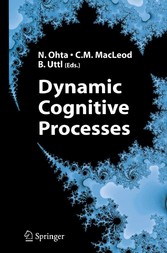Search and Find
Service
Preface
6
Contributors
9
Dynamic Cognitive Processes in Broad Perspective
17
Introduction
17
A Survey of the Book
19
Conclusion
24
Author Notes
25
References
25
Acquisition of Long-Term Visual Representations: Psychological and Neural Mechanisms
26
Introduction
26
Learning and acquisition of spatial regularities
28
Visual search and spatial regularities
29
Learning and acquisition of shape regularities
34
Acquiring new visual shape representations in normal participants
35
Acquiring new visual shape representations in nonhuman primates
42
Conclusion
46
Author Notes
47
References
47
Top-Down and Bottom-Up Processes in the Perception of Reversible Figures: Toward a Hybrid Model
51
Introduction
51
Extended Viewing of a Reversible Figure
55
Effects of Pre-exposure to an Unambiguous Figure
59
Intentional Control: Mechanisms and Limitations
63
Toward a Hybrid Model of Reversible Figure Perception
68
Author Notes
70
References
70
Dynamic Uses of Memory in Visual Search Over Time and Space
73
Introduction
73
Preview search
74
Negative carry-over effects and probe inhibition
76
Search with isoluminant stimuli
82
The relations between visual marking and other attentional processes
83
The neural substrate of preview search
86
Conclusions
87
Author Notes
88
References
88
Memory for Information Perceived Without Awareness
92
Introduction
92
Studies of memory for information perceived without awareness
93
Memory for events during anaesthesia
103
Concluding comments
108
Author Notes
110
References
111
The Devil Is in The Detail: A Constructionist Account of Repetition Blindness
113
Introduction
113
Experiment 1: On-Line Exogenous Cues
119
Experiment 2: Control Conditions
121
Experiment 3: Endogenously-Controlled Selective Processing
123
Experiment 4: Activation and Access to Identity
126
General Discussion
131
Author Note
137
References
137
Creation Theory of Cognition: Is Memory Retrieved or Created?
143
Is memory retrieved or created?
143
Retrieval versus Creation
144
Relation between recognition memory performance and familiarity
145
Non-linearity of familiarity
146
Explanation through list markers
148
The single node problem
149
Difficulties in identifying context elements
151
Multiple trace theory of memory representation
152
Mechanism of the process that generates non-linearity of familiarity
152
MINERVA2
153
Do humans store symbolic information?
154
Assumptions of the spiral representation theory
155
Activation Inter-Restraint Theory
157
Other assumptions
160
Simulation of familiarity by UME
161
Simulation of recall and symbol creation by UME
163
Author Notes
167
References
167
The Role of Inhibitory Control in Forgetting Unwanted Memories: A Consideration of Three Methods
170
Executive Control and the Mechanisms of Retrieval
172
Practiced Category Unpracticed Category Fruits Drinks
175
Orange Banana Scotch Rum
175
Forgetting Unwanted Memories: A Comparison of Methods
184
Directed Forgetting: the Phenomenon and its Interpretations
184
Author Notes
197
References
197
Encoding Deselection and Long-Term Memory
201
Introduction
201
Varieties of memory and division of attention
203
Dividing attention between two sources versus ignoring one source
208
Consequences of deselection: The Stroop task as a model
210
Stroop deselection and long-term memory
211
Mechanisms underlying deselection effects in perceptual priming
215
Protecting the target from deselection effects
217
Concluding remarks
220
Author Notes
221
References
221
List Method Directed Forgetting: Return of the Selective Rehearsal Account
228
Introduction
228
Directed Forgetting Methods and Terminology
231
Theoretical Accounts of Directed Forgetting
233
Early Evidence for Selective Rehearsal
237
New Evidence For a Rehearsal Account of List Method Directed Forgetting
241
Other Evidence Supporting a Selective Rehearsal Account
250
Conclusions
252
Author notes
253
References
253
Conscious and Unconscious Processes in Hypermnesia
258
Introduction
259
Conclusion
277
Author Notes
278
References
278
Age-Related Changes in Event-Cued Prospective Memory Proper
281
Introduction
281
Prospective Memory Proper (ProMP) Prospective Memory vs Prospective Memory Tasks
283
Age-related Differences in Prospective Memory Proper Theoretical Expectations
289
Aging and Visually and Auditorily Cued ProM Proper
298
Participants and Design
298
Section Summary
305
Conclusions
305
Author Notes
306
References
306
Prospective Memory Retrieval Revisited
312
Introduction
312
ProM tasks: Provisos
314
An analysis of episodic ProM task retrieval
315
ProM cues must be noticed
317
ProM cues must be singularized
322
Plans must be recollected
325
Ongoing Task Type
327
Singular experiences functions as task interrupts
329
Conclusion
333
Author Notes
334
References
334
Hippocampal Complex Contribution to Retention and Retrieval of Recent and Remote Episodic and Semantic Memories: Evidence from Behavioral and Neuroimaging Studies of Healthy and Brain- Damaged People
340
Introduction
341
A very brief history of the problem of remote memory and consolidation
343
The standard model
344
The relevance of the neuroanatomical components of the medial temporal lobes and related structures
347
Multiple Trace Theory
349
Tests of MTT and the standard model: Autobiographical memory
350
Parallels between anterograde and retrograde memory: A common mechanism?
360
Semantic memory for facts, events, people, and words
362
Prolonged consolidation for semantic memory: Two alternatives
367
Test of the standard model's and MTT account of the pattern of semantic memory loss in amnesia and dementia
371
Conclusion
375
Author Notes
377
References
377
Name Index
388
Subject Index
398
All prices incl. VAT













